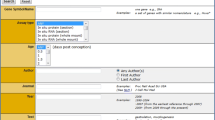Abstract
Many human diseases result from the (partial) loss of gene function. Once a disease-causing gene has been identified, a wide variety of techniques can be used to study its function, structure and expression. Many clues can be obtained from the comparison of RNA or proteins in tissues, cell extracts or cell lines at different physiological or developmental stages. Since the mouse genome is very similar to the human genome, expression data from mice are extremely valuable. Recently developed techniques to add genes to the mouse genome or to modify or inactivate genes form powerful tools to analyze gene function and expression. For a variety of human diseases these genetically modified mice are very informative model systems.




Similar content being viewed by others
Author information
Authors and Affiliations
Corresponding author
Rights and permissions
About this article
Cite this article
Claij, N., Peters, D.J.M. Teaching molecular genetics: Chapter 2—Transgenesis and gene targeting: mouse models to study gene function and expression. Pediatr Nephrol 21, 318–323 (2006). https://doi.org/10.1007/s00467-005-2110-7
Received:
Revised:
Accepted:
Published:
Issue Date:
DOI: https://doi.org/10.1007/s00467-005-2110-7




